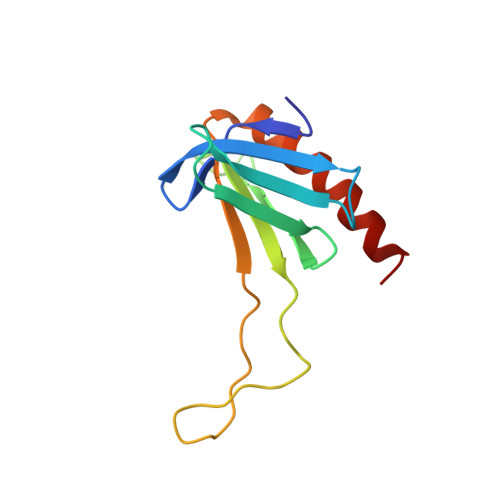A Omega XaV motif in the Rift Valley fever virus NSs protein is essential for degrading p62, forming nuclear filaments and virulence.
Cyr, N., de la Fuente, C., Lecoq, L., Guendel, I., Chabot, P.R., Kehn-Hall, K., Omichinski, J.G.(2015) Proc Natl Acad Sci U S A 112: 6021-6026
- PubMed: 25918396
- DOI: https://doi.org/10.1073/pnas.1503688112
- Primary Citation of Related Structures:
2N0Y - PubMed Abstract:
Rift Valley fever virus (RVFV) is a single-stranded RNA virus capable of inducing fatal hemorrhagic fever in humans. A key component of RVFV virulence is its ability to form nuclear filaments through interactions between the viral nonstructural protein NSs and the host general transcription factor TFIIH. Here, we identify an interaction between a ΩXaV motif in NSs and the p62 subunit of TFIIH. This motif in NSs is similar to ΩXaV motifs found in nucleotide excision repair (NER) factors and transcription factors known to interact with p62. Structural and biophysical studies demonstrate that NSs binds to p62 in a similar manner as these other factors. Functional studies in RVFV-infected cells show that the ΩXaV motif is required for both nuclear filament formation and degradation of p62. Consistent with the fact that the RVFV can be distinguished from other Bunyaviridae-family viruses due to its ability to form nuclear filaments in infected cells, the motif is absent in the NSs proteins of other Bunyaviridae-family viruses. Taken together, our studies demonstrate that p62 binding to NSs through the ΩXaV motif is essential for degrading p62, forming nuclear filaments and enhancing RVFV virulence. In addition, these results show how the RVFV incorporates a simple motif into the NSs protein that enables it to functionally mimic host cell proteins that bind the p62 subunit of TFIIH.
Organizational Affiliation:
Department of Biochemistry and Molecular Medicine, Université de Montréal, Montréal, QC, Canada H3C 3J7; and.















